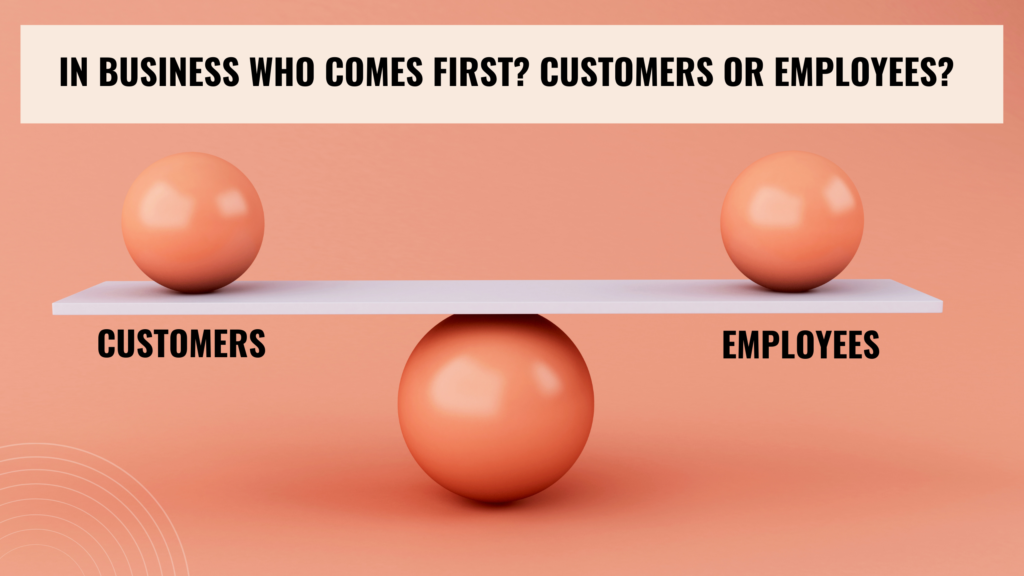Let’s first acknowledge that customers run the business, but employees run the show. So my response to the question of who comes first is that both do, depending on whether you’re looking in or looking out of the business. If a business is looking inward, its employees come first. If it’s looking outward, then its customers come first. As we know, perspective is everything.
If a business is looking inward, its employees come first. If it’s looking outward, then its customers come first. As we know, perspective is everything.
A Customer-First perspective ensures that customers remain happy, because the business is providing solutions that improve their lives and an Employee-First perspective ensures that employees come to work happy. It augurs well for the bottom line if both groups are kept happy.
In a Customer-First and Employee-First universe, there is a separation between who pays the bills (the customer) and who delivers the goods (the employees). Whilst we know at an intellectual level, that these two audiences are inextricable, businesses tend to be preoccupied with only one and that’s the former, the customer.
I like to ask business leaders three simple questions when I’m doing client discovery sessions. Firstly, “What do you know about your customers?” secondly, “What do you know about your market?” and thirdly, “What do you know about your employees?” I’ve discovered that the intelligence is lopsided. Leaders know more about their customers and their markets, than about their employees for the simple reason that they put more effort into building intelligence around questions relating to customers and markets. No surprises here. The overriding belief is that the customer is king and the customer is queen, so a disproportionate amount of effort is dedicated to customer “satisfaction.” I used the word “satisfaction” intentionally, because we know that many businesses don’t put a lot of effort into exceeding customers’ expectations.
Leaders know more about their customers and their markets, than about their employees for the simple reason that they put more effort into building intelligence around questions relating to customers and markets.
There is a huge blind spot here and that’s the failure to ascribe equal importance to the individuals who deliver the goods to the customer. It’s akin to a restaurant basking in the glory of producing delectable meals every day, without celebrating the chefs who churn the meals out. One is not possible, without the other. But, the blind spot prevails nevertheless.
The time is long overdue to close the Customer-First and Employee-First gap. The actions that form part of the Employee-First strategy, are slightly different to those found in a Customer-First strategy. Two helpful starting points would be to have businesses think of their employees as profit generators, instead of cost centres and to acknowledge employees as their first customers. In a previous professional capacity, the company with which I was employed as a Human Resource Manager, regarded and treated employees as profit centres, in a meaningful and not cosmetic way. Needless to say, employee loyalty was high.
Next up is the fact that we are returning, largely, to a Work-From-Office (WFO) model. This reverse movement is called the “Great Return” and businesses need to plan carefully for its successful execution. In the early days of the Work-From-Home (WFH) model, empathy became the buzzword that coloured the team-engagement narrative. As workplaces reset, empathy should evolve into “meaningful empathy” or the authentic interest in employee well-being. “Meaningful empathy” therefore, becomes more than, “How are you today?” and other equally fluffy questions that are asked without authentic interest in the answers.
Two helpful starting points would be to have businesses think of their employees as profit generators, instead of cost centres and to acknowledge employees as their first customers.
Meaningful empathy is about acknowledging that individuals have deep-seated psychological needs, which, when met, release powerful motivational energy that then powers performance. These needs include the need to feel significant (valued), to feel connected to a community (belonging), to grow (contribute) and to experience a sense of order (predictability over chaos). So, all of this goes beyond a superficial enquiry about how the day is going.
The Great Return is a not-to-be-missed opportunity for businesses to initiate an Employee-First movement that creates a balance between four powerful forces that influence profit. Customer success, employee engagement, creativity and innovation.
Oh and another thing. I have a curious mind and I thrive in environments that welcome respectful expression of thoughts, ideas and differences of opinion (cultures of curiosity).
The Great Return is a not-to-be-missed opportunity for businesses to initiate an Employee-First movement that creates a balance between four powerful forces that influence profit. Customer success, employee engagement, creativity and innovation.
The Great Return is an ideal platform for curating opportunities that feed and unleash curious minds.
I suspect that there are many minds like mine out there.

